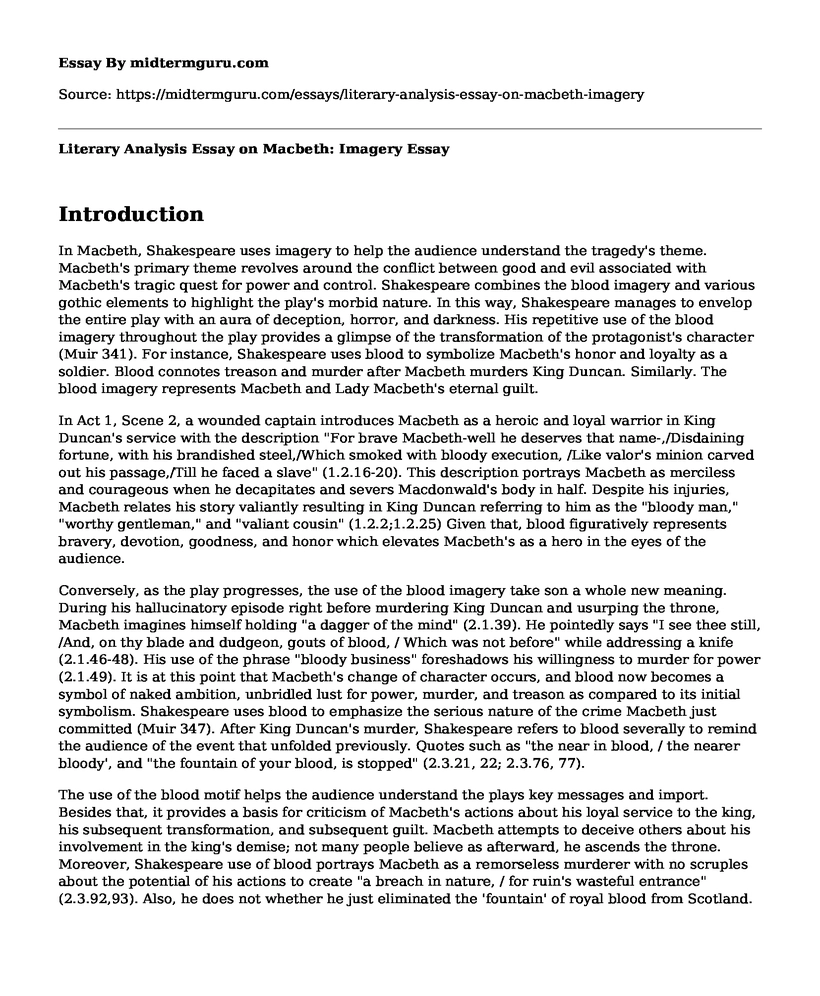Introduction
In Macbeth, Shakespeare uses imagery to help the audience understand the tragedy's theme. Macbeth's primary theme revolves around the conflict between good and evil associated with Macbeth's tragic quest for power and control. Shakespeare combines the blood imagery and various gothic elements to highlight the play's morbid nature. In this way, Shakespeare manages to envelop the entire play with an aura of deception, horror, and darkness. His repetitive use of the blood imagery throughout the play provides a glimpse of the transformation of the protagonist's character (Muir 341). For instance, Shakespeare uses blood to symbolize Macbeth's honor and loyalty as a soldier. Blood connotes treason and murder after Macbeth murders King Duncan. Similarly. The blood imagery represents Macbeth and Lady Macbeth's eternal guilt.
In Act 1, Scene 2, a wounded captain introduces Macbeth as a heroic and loyal warrior in King Duncan's service with the description "For brave Macbeth-well he deserves that name-,/Disdaining fortune, with his brandished steel,/Which smoked with bloody execution, /Like valor's minion carved out his passage,/Till he faced a slave" (1.2.16-20). This description portrays Macbeth as merciless and courageous when he decapitates and severs Macdonwald's body in half. Despite his injuries, Macbeth relates his story valiantly resulting in King Duncan referring to him as the "bloody man," "worthy gentleman," and "valiant cousin" (1.2.2;1.2.25) Given that, blood figuratively represents bravery, devotion, goodness, and honor which elevates Macbeth's as a hero in the eyes of the audience.
Conversely, as the play progresses, the use of the blood imagery take son a whole new meaning. During his hallucinatory episode right before murdering King Duncan and usurping the throne, Macbeth imagines himself holding "a dagger of the mind" (2.1.39). He pointedly says "I see thee still, /And, on thy blade and dudgeon, gouts of blood, / Which was not before" while addressing a knife (2.1.46-48). His use of the phrase "bloody business" foreshadows his willingness to murder for power (2.1.49). It is at this point that Macbeth's change of character occurs, and blood now becomes a symbol of naked ambition, unbridled lust for power, murder, and treason as compared to its initial symbolism. Shakespeare uses blood to emphasize the serious nature of the crime Macbeth just committed (Muir 347). After King Duncan's murder, Shakespeare refers to blood severally to remind the audience of the event that unfolded previously. Quotes such as "the near in blood, / the nearer bloody', and "the fountain of your blood, is stopped" (2.3.21, 22; 2.3.76, 77).
The use of the blood motif helps the audience understand the plays key messages and import. Besides that, it provides a basis for criticism of Macbeth's actions about his loyal service to the king, his subsequent transformation, and subsequent guilt. Macbeth attempts to deceive others about his involvement in the king's demise; not many people believe as afterward, he ascends the throne. Moreover, Shakespeare use of blood portrays Macbeth as a remorseless murderer with no scruples about the potential of his actions to create "a breach in nature, / for ruin's wasteful entrance" (2.3.92,93). Also, he does not whether he just eliminated the 'fountain' of royal blood from Scotland.
Conclusion
In conclusion, Shakespeare clever use the blood imagery to arouse instinctual reactions in the audience as blood typically represents birth, death injury, continuity, and regeneration. Also, blood is an essential element of man's corporeal existence without which it is impossible to functions normally. Shakespeare use of the blood imagery helps the audience relate to the tragedy at the most basic level, as it lets the audience become a part of the actions.
Works Cited
Muir, Kenneth. "Image and symbol in Macbeth." Macbeth. Routledge, 2015. 337-351.
Shakespeare, William. "The Tragedy of Macbeth. 1606." Ed. Nicholas Brooke. London: Oxford UP (1998).
Cite this page
Literary Analysis Essay on Macbeth: Imagery. (2022, Sep 11). Retrieved from https://midtermguru.com/essays/literary-analysis-essay-on-macbeth-imagery
If you are the original author of this essay and no longer wish to have it published on the midtermguru.com website, please click below to request its removal:
- Rue by Philip Levines - Poem Analysis Paper Example
- Poem Explication of First Writing Since - Paper Example
- Paper Example on Heroism in Sir Gawain and the Green Knight
- Poetry Analysis Essay on Finding Hope by Pat A. Fleming
- Winston Smith, Hero or Not? - Essay Sample
- Literary Analysis Essay on "Pheno Timers", "For Me From You "And "the Poem at Thirty-Nine"
- Literary Analysis Essay on Heinrich Heine's Loreley & Its Influence







